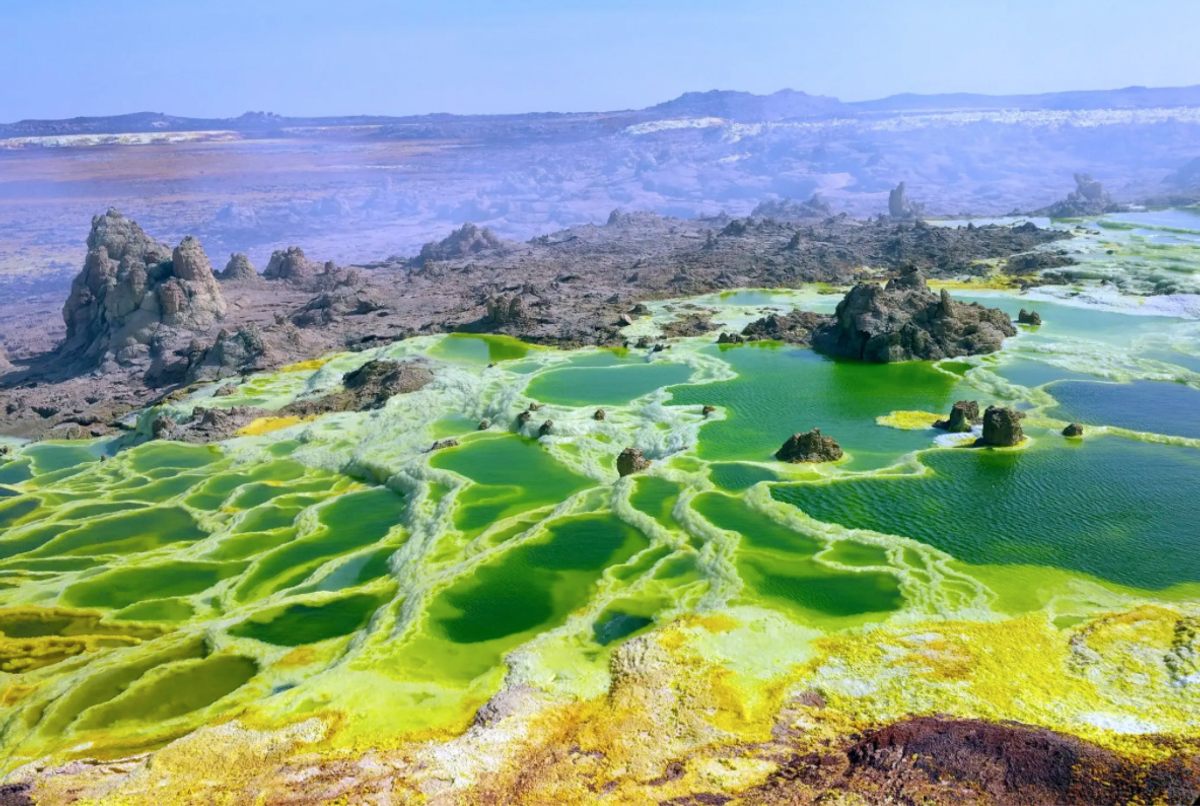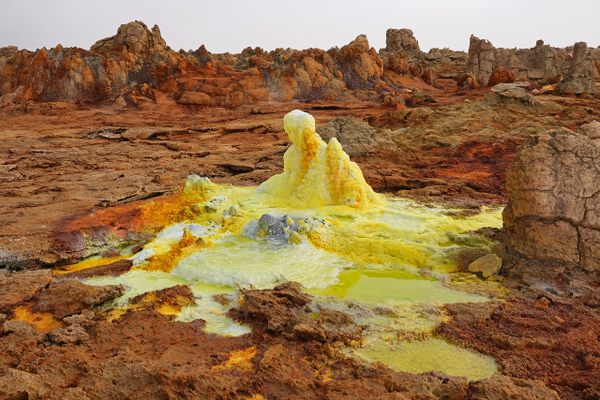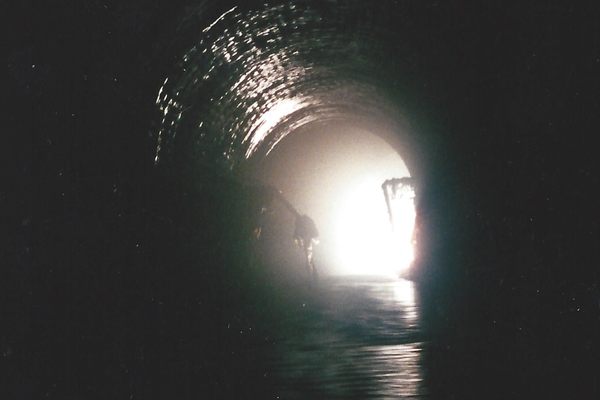
Searching for the Limits of Life in Earth’s Most Extreme Environment
In Ethiopia’s Danakil Depression, a continent is tearing itself apart, and volcanic chemicals fuel ecosystems unlike anything else on the planet.
Excerpted from Super Volcanoes: What They Reveal About Earth and the Worlds Beyond. Copyright (c) 2021 by Robin George Andrews. Used with permission of the publisher, W. W. Norton & Company, Inc. All rights reserved.
The science is in: Lava, while molten, is bad for life. It flambés it to death. But microbes can thrive in conditions most animals would find abhorrent. The same is true for much of the East African Rift, with watery pools home to all kinds of life sitting between fresh, jagged lava flows still baking underneath a thin crust.
And then you’ve got Ethiopia’s Danakil Depression.
Sitting within the larger Afar Depression near the top of the rift, the tectonically active area where the African plate has been slowly splitting for around 20 million years, Danakil is more than 330 feet below sea level. Only a volcanic mound along the coast stops it from being flooded. “But when the sea level was higher” in the distant past, says Christopher Jackson, an expert in geologic basins at Imperial College London, “there used to be marine waters in the Danakil Depression.” Ancient coral reefs, marine terraces, and salty minerals stand as memories to the watery land this once was.

To say it is a hostile place today is a gross understatement. This 160-mile-long bowl has daily average temperatures of 94 degrees Fahrenheit, making it one of the most sun-scorched places on Earth. Rain is a rarity, with only four inches of the good stuff falling on Danakil each year. And within Danakil you can find a volcano named Dallol, flanked by countless hydrothermal ponds and pools. It is a polychromatic hellscape. Volcanic chemicals brought up by the East African mantle monster—the plume of super-heated magma that is sundering the continent from below—decorate the waters in vibrant greens, luminous oranges, milky whites, and sickly yellows. The air bakes in the stench of rust, eggy sulfur, and acrid chlorine. These viscous vapors bite the inside of your nasal cavities and fire tiny splinters into your lungs if you dare to approach the small mineralized mounds looming over the wheezing pools.
Purificación López-García, a microbial diversity expert at the French National Center for Scientific Research, has worked around Dallol in temperatures exceeding 122 degrees Fahrenheit. You have to drink water constantly and move very slowly so you don’t overheat. Working here and in the surrounding region was, she says, “the most extreme experience I had in my life.” Felipe Gómez, a microbiologist with the Astrobiology Center in Madrid, Spain, says that Dallol looks very beautiful, but it is incredibly hot and full of death. “Some birds see water and dive down [to drink] and die over there,” he says. “It’s possible to see some of the small pools surrounded by birds that have died. Yeah, it’s horrible.”

But, as the axiom goes: Where there is water, there is life. As long as there is water and some chemical compounds that can be used to make energy, certain species of microbes—extremophiles—can make Dallol their domicile. Remarkably, some microbes can exist in a combination of two of these environmental extremes, making them polyextremophiles. And showoffs.
The same applies to Dallol, at least up to a point. Hardy microbes have evolved to withstand very high temperatures. Some can live in extremely salty environments too, while others thrive in remarkably acidic (low pH) environments. “We normally say that pH is zero, because we have no probes adapted to measure a negative pH. In theory, a negative pH doesn’t exist,” says Gómez. But here, some pools almost certainly have a negative pH. And yet, life finds a way.

Dallol has hyperthermal pools, hypersaline ponds, and hyperacidic puddles. But what makes it such a draw for microbiologists is that, thanks to its anomalous and enormous volcanic fuel source, it has bodies of water that check all three boxes, making it the most extreme environment for life on Earth. Life flits about in some of these watery pools, but others, says Gómez, are completely sterilized. Sometimes the extremes are, well, a little too extreme for life. Sometimes the water in the pools is so bound up with other chemical compounds that not enough is available for microorganisms to use themselves.
“In every extreme environment where I have been, if I found water, I found life,” he says, speaking of his adventures to both the North and South Poles, the Atacama Desert, and so on. “The only exception is here at Dallol.”
Barbara Cavalazzi, a geobiologist and astrobiologist at the University of Bologna, says that this is the perfect place to study astrobiology, or the search for and study of life beyond Earth. If life is found in these pools, then it is living right at the limits of biology on this planet. If life is absent, then perhaps we have found a set of conditions that prevents any life from existing, a concept that may apply to environments on other worlds. That makes finding where the limit lies in Dallol—arguably the most otherworldly consequence of the East African Rift—a scientific endeavor with profound consequences.

In 2019, Gómez and his colleagues published a paper that looks to have pushed the limits to life even further into the unfathomable beyond. A few years back, while using the Danakil Depression to calibrate a scientific instrument that would ultimately end up on NASA’s Curiosity rover on Mars, they poked about in the pools around Dallol and found fatty acids, the sort that can be found in cells. While ruling out possible contamination from scientists, tourists, and animal life, they identified minuscule round structures entombed within mineral deposits. They concluded that these were the cells of bacteria.
This was a huge surprise. Life on Earth had never been found in a simultaneously hyperacidic, hyperthermal, and hypersaline environment, the combination seemingly proving too much to handle. And yet, in this pool of death, it appears that something could survive. Stranger still, these sorts of microbes had been found before in other salty environments, but not in this most extreme of settings. Gómez and his team are currently trying to unravel the biophysical mechanisms that permit the microbes’ survival, work that is truly at the leading edge of microbiology.
Later that year, López-García and her colleagues published a paper that indirectly ran contrary to this discovery. Looking in similar pools with all three environmental extremes, they came away empty-handed. They found that the preponderance of salt and acidity proved to be too disruptive to life. High concentrations of magnesium salts present were capable of shattering chains of molecules and the protective membranes wrapped around cells. “They suck up the water” that cells need, she says—a fatal blow for microbes. The team also suggested that tiny grains within the pools certainly resemble cells, but are nothing more than mineralogic mimics that can be misinterpreted as evidence for life.

Gómez remains upbeat and confident. A few years ago, he says, he would not have believed the results of his paper either. But the limits for life seem to only extend further away as each year passes.
What everyone does agree on, though, is that the only reason life can function at all at Dallol is because of the volcanism that permeates East Africa. Volcanoes provide crucial heat and the flow of chemicals that microbes can use as energy sources. Sprinkle on some water, and you have a home for adventurous little critters.
Volcanoes can be dangerous. “But from a scientific perspective, it’s quite the opposite,” says Gómez. “The origin of planet Earth is volcanoes.” And no one knows for certain, but these sorts of habitats are probably like those that first gave rise to life, from which every living thing today has descended.



























Follow us on Twitter to get the latest on the world's hidden wonders.
Like us on Facebook to get the latest on the world's hidden wonders.
Follow us on Twitter Like us on Facebook